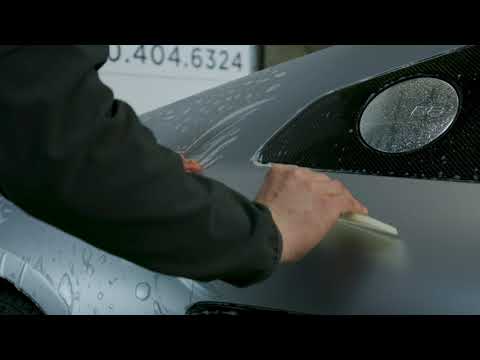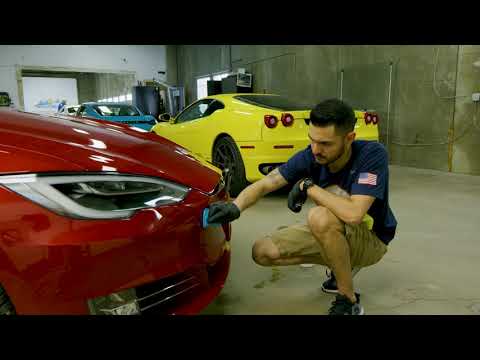You just bought your dream car and want its pristine and gloss to remain the same way even after years of using it. But with everything that we buy, there is a specific time before it starts losing out its worth. The same is true for our cars. Over the course of time, you won’t be able to maintain the same level of gloss and shine that once came with the vehicle the day you bought it.
Our cars are the safest when parked in the garage, but that’s not why they are built. Your car will act as your daily driver, and you need to take great care of it to ensure its longevity.
Over $10 billion is spent on car wash and paint protection in the US alone every year. That’s a lot of hard-earned money invested in maintaining the shine of a car.
At Best Clear Bra, we are often asked several questions:
- Carnauba car wax vs. ceramic coating, which is better?
- Is it worth the investment?
- How long would the paint protection or wax last?
- Does my car even need it?
- If I’m able to ceramic coat or wax the car myself, why should I hire a professional?
- What are the benefits of car wax?
- What are the benefits of ceramic coating?
- What are the costs of ceramic coating and waxing?
There are no absolute right or wrong answers to these questions. It depends on what exactly you need with your car. Unfortunately, many people, including some mechanics, use both terms interchangeably, causing a great deal of confusion. In reality, car wax and sealant are two different products. While they serve as the primary method of coating your car with an added layer of protection, the former is not as durable as the latter.
With technological advances, paint protection methods and coating have advanced. However, car wax has more or less remained the same.
In this guide, we’ll be sharing two popular and commercially available paint protection solutions available; carnauba car wax and ceramic coating. Which one comes out to be the clear winner? Let’s find out.
- What is Car Wax?
- What Are the Different Type of Car Waxes?
- How Long Does Car Wax Last?
- How to Apply Car Wax?
- What Are the Benefits of Using Car Wax?
- What Are the Drawbacks of Waxing Your Car?
- What is Ceramic Coating?
- How to Apply Ceramic Coating?
- How Long Will Ceramic Nano Coating Last?
- What are the Benefits of Ceramic Coating?
- What are the Drawbacks of Ceramic Coating?
- More Expensive than Waxing
- Not a DIY Friendly Process
- Ceramic Coating vs. Car Wax, Head-to-Head Comparison
- Can you Use Wax and Ceramic Coating Together?
What is Car Wax?
Car wax, also popularly known as Carnauba car wax, is derived from a palm plant native to Brazil. The wax is found on the leaves that protect it from the sunlight’s harsh UV rays. It is then refined and applied in numerous industries such as dental floss, automotive, shoe polish, etc.
In the automotive industry, it is used to protect the factory paint coat of a car. Since car waxes contain natural ingredients, they are more prone to damage as compared with ceramic coating.
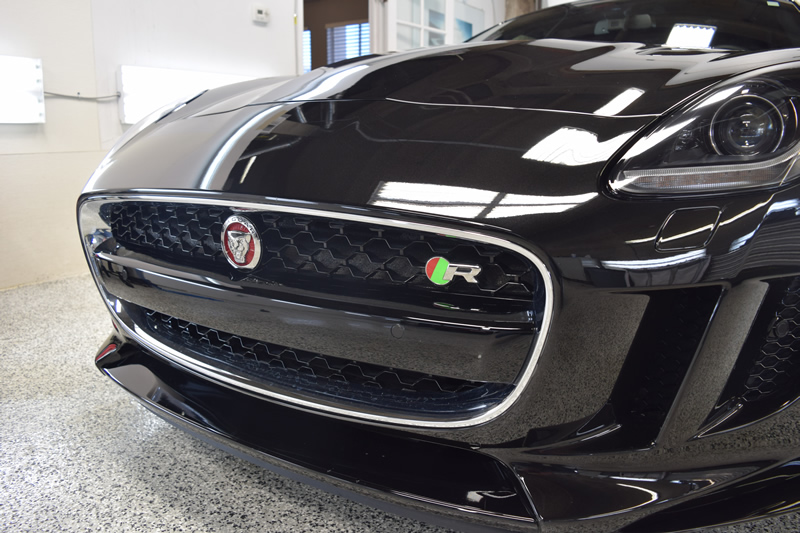
What Are the Different Type of Car Waxes?
There are different types of car waxes, with each having various price tags and features. Here is a summary of the most common types of wax available in the market today:
Carnauba Car Waxes
As discussed earlier, it is a refined form of natural wax derived from a Brazilian palm tree. Don’t be fooled, though. Many wax brands will advertise their products containing 90% carnauba, whereas they do not contain over 30% of carnauba wax. In terms of shine and color, they provide the best protection.
Synthetic Car Waxes
These are entirely artificial forms of synthetic paint sealants. While they can last for up to a year, they don’t produce the same level of shine and UV protection compared with carnauba car waxes. However, if you want a rapid and time-effective solution, you should go for synthetic car waxes.
Cleaner Waxes
Cleaner waxes are akin to synthetic waxes but perform a 3 in 1 job cleaning, polishing, and protecting the car’s factory coat. The cleaning agents clean and polish your car. They are a good choice if the factory coat has deteriorated over the years. Do note that the shine and protection you get either from carnauba or synthetic waxes is not the same you’ll get from cleaner waxes.
How Long Does Car Wax Last?
Car waxes and ceramic coating are not the same and hence will differ in their lives. Some car wax manufacturers claim that their waxes can last for up to 6 months, whereas others claim a lifetime shine and gloss. In reality, car waxes do not last more than 3 months, provided you take great care of your car.
How to Apply Car Wax?
Applying wax is a time-taking process involving a great deal of prep work. It all starts with washing your car and drying it with a clean microfiber cloth.
Here is the entire process you need to follow afterward:
Work Under the Shade
Instead of applying the car wax under direct sunlight, it has been recommended to work under shade.
Apply Wax on a Soft Foam
Now you need to dry the car with a microfiber cloth or towel. Once completely dried, use a soft foam applicator to apply the wax in a circular motion gently.
Wait for 10 Minutes
Wait for 5 to 10 minutes for the wax to dry. This is important to get the final results after buffing. If the wax is not dried up, you can have a hard time getting that much-needed pristine.
Buff the Surface
Now buff the surface either with a variable speed buffer or a soft fiber cloth. It is recommended to use a speed buffer as it provides consistent speed and saves a lot of time evenly buffing the wax on each panel.

What Are the Benefits of Using Car Wax?
There are several benefits of waxing your car:
- It is a cost-effective method of protecting the factory coat
- Car wax is an environmentally friendly product due to the high volume of carnauba wax.
- It is relatively simple to apply. Wash your car, clean it with a microfiber cloth, and apply the wax.
- Heat and UV resistant
- Excellent hydrophobic properties of resisting water.
What Are the Drawbacks of Waxing Your Car?
Before waxing your car, it is recommended to go over the following points:
- It lasts up to 8 weeks and needs to be reapplied frequently. If you do not reapply, your car’s paint will not remain protected.
- Applying car wax is a highly labor-intensive process involving a considerable amount of prep work and details. While it is relatively simple to use a ceramic coating, we won’t recommend doing it yourself in your garage.
What is Ceramic Coating?
Also known as Nano Ceramic Coating, it is a liquid polymer with a high concentration of silica used to protect the factory coat of your car. Despite being synthetic, it provides a greater level of paint protection as compared to carnauba wax. The new nanotechnology ceramic coating is becoming increasingly popular among Denver car owners.
With advancements in technology, the ceramic coating has dramatically improved the lifespan of paint protection. Compared to just 8 weeks for wax, a properly ceramic coated car is well-protected for as long as 6 months.
The ceramic coating contains chemicals that bind with the surface of your car. Once applied, your car becomes exceptionally resistant to water and acidic environment substances such as bird droppings and rain.
Ceramic coating is much more durable and provides better protection from UV rays, heat, rain, and environmental contaminants than car wax. The main difference between wax and nano-ceramic coating is that the former simply sits on the car’s surface, whereas the latter chemically binds with it. This gives the ceramic coating a unique competitive edge over other polishing and waxing materials as an ultimate solution to your car’s shine and gloss.
How to Apply Ceramic Coating?
Unlike car waxing, applying the ceramic coating is slightly more complex, time-taking, and varies based on the wide range of types of coating available in the market. Several factors are taken into account in the application of ceramic coating:
- Are you doing it yourself or hiring a professional?
- Which brand is it?
- Have you read the instructions or the user manual carefully?
Start by working in a shaded area and follow the steps below:

Wash and Dry Your Car
Wash your car and have it dried thoroughly with a microfiber cloth. How well you clean your car has a direct impact on the shine of ceramic coating.
Clay Bar Treatment
You now need to treat your car with a clay bar. This step is known as the clay bar treatment. The professionals will use an industrial standard of hard clay along with a lubrication fluid to get rid of grime and sap. Clay bar treatment can quickly clear the paint surface by penetrating hard-to-reach areas and filling the microscopic holes on the factory coat.
Application of Ceramic Coating
Once it is completely dried, start with the application of ceramic coating using a soft sponge in a circular motion. Focus on one panel at a time. Wait at least 30 minutes for the coating to completely dry and buff with a variable speed buffer. While buffing, the ceramic coating will start binding with the car’s surface creating superhydrophobic properties.
How to Choose a Reliable Ceramic Coating Installer?
How Long Will Ceramic Nano Coating Last?
Among the numerous advantages, the biggest one is that the ceramic coating provides superior paint protection for up to 6 months, and at times, up to a year.
What are the Benefits of Ceramic Coating?
Similar to car waxing, the ceramic coating has many benefits:
Protects Against UV Rays
Ceramic coating provides better protection against UV rays as compared to traditional waxing.
Long-Lasting
Ceramic coating manufacturers have their own set of timelines that they suggest for reapplication. In reality, it can easily last for up to 6 months. Brands such as Armor can provide the ultimate protection for up to 2 years.
Superhydrophobic Properties
Ceramic coating makes your car’s surface extremely hydrophobic, making it resistant to water, UV rays, acid rain, and bird dropping.
What are the Drawbacks of Ceramic Coating?
Like every other car detailing product, the ceramic coating has its own set fair share of problems.
More Expensive than Waxing
Many people often wonder if it is worth paying as much as 6 times the cost of waxing your car. Ceramic coating, including the product and labor cost, will usually set you back around $1,000 or even more. For a typical car wax, expect to pay no more than $200. The cost is an important factor you need to take into account while opting to ceramic coat your car.
Not a DIY Friendly Process
Unlike waxing, it is neither recommended nor wise to apply a ceramic coating on the car by yourself. It will require a considerable amount of prep work and the help of highly professional and skilled car detailing enthusiasts. If you’ve never done this before, it is better to invest in hiring a professional rather than doing it all yourself.
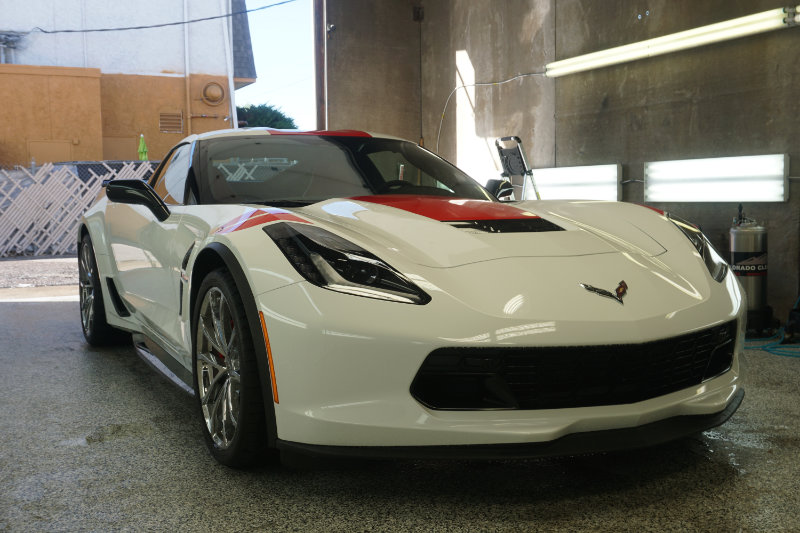
Ceramic Coating vs. Car Wax, Head-to-Head Comparison
We have summed up the differences and similarities of ceramic coating and car wax in the following bullet points in an attempt to help you understand both of them efficiently:
- Car waxes and ceramic coating both serve the purpose of protecting your car factory coat and adding a layer of protection that helps in blocking UV rays.
- Both add an incredible amount of shine and gloss to your car.
- Car waxes typically last for about 6 to 8 weeks, whereas ceramic coating lasts for up to 6 months, and at times up to a year. How long both last depends on how well you regularly keep your car maintained.
- Waxes are refined natural products and are favored among classic car enthusiasts.
- Ceramic Coating is entirely synthetically made from polymers that chemically bond to your car’s factory coat, offering long-lasting protection.
- Both are applied similarly and require a great deal of prep work.
Here is a table comparing car wax and ceramic coating:
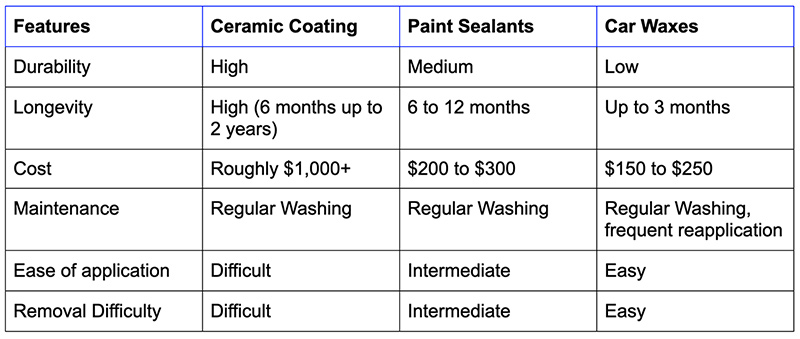
Can you Use Wax and Ceramic Coating Together?
Yes, you can. But what purpose does it serve? Ceramic coating costs nearly $1,000, so why invest an extra $150 to $200 on waxing? Both are two different materials with the ultimate goal of protecting your car’s paint.
In the end, it depends mainly on the time and budget you can allocate in protecting the exterior surface of your car.



